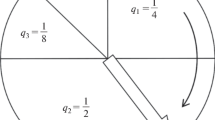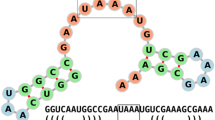Abstract
We discuss the origin of life in terms of an RNA World scenario in which the creation of autocatalytic sequences is the key step. Our computational models illustrate that life arises by a rare stochastic event that occurs due to spatially localized concentration fluctuations. This allows the chemical system to jump from a non-living state with very low ribozyme concentration to a living state that is controlled by ribozymes. Once the living state is established locally, it can spread deterministically through the rest of the system. These are generic features also possessed by more complex models with a greater degree of chemical realism.
Similar content being viewed by others
One of the key issues at the meeting on Open Questions on the Origin of Life, held recently in Leicester, was the way in which biology emerges from chemistry. A commonly used definition of life, sometimes referred to as the NASA definition, states that life is a self-sustained chemical system capable of undergoing Darwinian evolution. Life as we know it is self sustained because it uses biopolymer catalysts to control its metabolic reactions. It is capable of evolution because it stores information in the form of a biopolymer sequence that can be replicated. As both these key aspects of life rely on biopolymers, we adopt the view that the origin of life means the origin of autocatalytic, information-carrying biopolymer systems. On Earth, it seems likely that RNA was the biopolymer performing both catalytic and genetic roles in early organisms (Joyce 2002), and we therefore present our arguments in terms of an RNA World scenario. However, our central points regarding the importance of local concentration fluctuations and the stochastic nature of the transition to life remain applicable if some other kind of replicating system arose prior to or instead of the RNA World.
The most important evidence that RNAs preceded proteins is that information in the form of mRNA is used to direct protein synthesis and that the translation process is catalyzed by rRNA. The most important evidence that RNA preceded DNA is that deoxyribose is synthesized from ribose in modern organisms and that this mechanism is not universal in all domains of life (Burton and Lehman 2009). These things strongly suggest that there was an RNA world in the early stages of life. Furthermore, there is strong experimental evidence that RNAs can catalyze the types of reaction that would be required in an RNA world, such as nucleotide synthesis (Unrau and Bartel 1998; Lau et al. 2004; Lau and Unrau 2009) and polymerization (Johnston et al. 2001; Zaher and Unrau 2007; Wochner et al. 2011). Examples of ribozymes that can support autocatalysis are known in the lab (Hayden et al. 2008; Lincoln and Joyce 2009). There has also been recent progress in understanding the prebiotic synthesis of nucleotides (Powner et al. 2009) and in showing that synthesis of relatively long RNA sequences is possible by non-biological means, which must have been the case prior to the origin of life (Ferris 2002; Rajamani et al. 2009, 2010; Costanzo et al. 2009). Of the many alternative ideas for the origin of life, none is supported by experimental demonstrations to this extent.
We have studied scenarios for the origin of the RNA World from non-living chemistry using mathematical models of RNA polymerization (Wu and Higgs 2009, 2011). These models have two stationary states corresponding to non-living and living systems. In the non-living state, polymerization is possible to some degree at a slow spontaneous rate, but the system is dominated by monomers and short oligomers, and the concentration of polymers long enough to be ribozymes is negligible. In the living state, reaction rates are controlled by ribozymes and there is a significant concentration of long polymers that can act as ribozymes. If ribozymes that catalyze either monomer synthesis or polymerization arise, these greatly increase their own production rate. Thus, the living state is autocatalytic.
The chemical system is in the non-living state prior to the origin of life. In a large, well-mixed system, the non-living state is dynamically stable indefinitely. For life to arise, we require concentration fluctuations that may occur in a finite sized region with finite numbers of molecules. Ribozymes are likely to be rare in the mixture of random sequences formed in the non-living state. There may only be a handful in any small volume, but this means that concentration fluctuations of these catalysts are large compared to the mean. We have shown that a few ribozymes can have a big effect in a finite volume, and that this can cause the system to jump between the basins of attraction of the non-living and living states. Once the system is living, RNA polymerization becomes efficient because it is catalyzed by ribozymes. The concentration of ribozymes is high, and fluctuations are less important. Thus the finite system remains stable in the living state.
We have carried out stochastic simulations of finite sized systems (Wu and Higgs 2009) and measured the mean time required for the transition to life to occur. If the volume of the system is increased, keeping the concentration constant, the number of molecules increases in proportion to the volume, and the relative concentration fluctuations decrease. For this reason the time taken for the transition increases rapidly with system size and becomes prohibitively long for large systems. This result points to an important factor missing from our model up to now—spatial diffusion of molecules. For a very large system like the Earth, the assumption of a well-mixed reaction system cannot be true, as molecules can only diffuse a finite distance before they are destroyed or undergo a further reaction. Thus concentration fluctuations are localized in space.
Here, we consider a simplified generic model of replicators that has the same essential features as our RNA polymerization models. This allows us to investigate the effect of the spatial distribution of replicators on the stochastic transition that leads to the origin of life. We consider a system with replicators on a square lattice of size L × L. Replicators can appear by random polymerization at a very slow spontaneous rate. Existing replicators may also act as polymerases that catalyze the replication of another replicator on the same site. The latter process occurs when there are exactly two replicators on a site—“two’s company, three’s a crowd”. Replicators also die at a constant rate and can hop to neighbouring sites at a rate h. When h is large, the system is well-mixed, and the dynamics of the system can be solved. There are two stable states, with low and high replicator concentrations, which correspond to the non-living and living states in the RNA polymerization model. When stochastic simulations are performed, the density converges initially to the non-living state but then a stochastic transition occurs, leading to a high density in a localized region. The high density patch then spreads deterministically across the lattice.
As the origin of the living state in this model is a rare stochastic event, the waiting time until the transition to life occurs is different each time the simulation is run. The mean time required for the origin of life depends on the lattice area, L 2, and on the diffusion rate, h, as shown in Fig. 1. In the well-mixed limit, the transition requires global-scale concentration fluctuations and becomes increasingly more difficult as the lattice size increases (black curve). In the low-h case, widely-separated regions behave independently; hence the time required decreases with lattice size in proportion to 1/L 2, once the lattice is larger than the correlation distance for concentration fluctuations. The blue curve shows the time until the transition occurs somewhere in any one region of the lattice. The red curve shows the time until the high concentration living state has spread across the whole lattice. For the intermediate region of Fig. 1, the time for spreading across the lattice after the origin has occurred is much shorter than the waiting time for the origin to occur. Hence the two curves coincide. For the largest lattice sizes, the time for spread becomes comparable to the waiting time for the origin, and the two curves separate. In this regime, the lattice is large enough for the stochastic transition to occur more than once independently in different locations before the living region from the first transition has spread across the whole system.
Mean time taken until the transition to life occurs in a simple model of replicators on a lattice of area L 2. The transition is much more rapid in a model with local spatial diffusion of molecules than in a well-mixed model with global hopping. In the local hopping case, the transition time is proportional to 1/L 2, for the relevant range of lattice size
As far as we know, Earth life is descended from a single origin. This is what we would expect if the stochastic event that creates life is very rare. It will be necessary to wait a very long time for it to happen even once somewhere on the surface of a planet. However, once the living state is established somewhere, the time scale for growth and spread of this state across the surface is very much faster than the initial waiting time. We do not know all the details of the chemical conditions on the primordial Earth that would determine the lifetime of a biopolymer such as RNA before it is broken down or destroyed. Maybe the lifetime is on the scale of hours or days at best. The challenge in the Origin of Life field is to understand how a molecular replication process could arise that is efficient enough to give a net multiplication rate that is faster than the breakdown rate. But once such a rapid replication cycle is established, the population spread and sequence evolution also occur on this rapid scale. The window of time during which life is thought to have evolved on Earth is a few hundred million years, which is a small fraction of the age of the Earth, but which is vast on the molecular time scale. Thus, given that planetary lifetimes are measured in billions of years, the origin of life can have a very low rate indeed and yet still have a significant chance of occurring on any given Earth-like planet. Given the subsequent rapid timescale of molecular replication and evolution, life, once it arises, has the capacity to very rapidly transform a planet and to spread to all available habitats on the surface.
We will conclude by relating our arguments to the issue of contingency versus determinism that came up at this meeting and has been discussed previously (Luisi 2006). Our central point is that the chemical conditions prior to the origin of life must have been such that the existence of a replicating molecular system (the living state in our models) was possible. ‘Possible’ does not mean ‘inevitable’. If we were able to study other Earth-like planets elsewhere, we might find instances where life did not emerge, or where the origin of life took a much longer or shorter time than we believe was the case on Earth. However, rare events remain within the scope of legitimate scientific inquiry. To quote Luisi (2006): “this view is not against the laws of physics and chemistry, nor is it equivalent to advancing the idea of a miracle, it is just a stochastic view of the implementation of natural laws.”
References
Burton AS, Lehman N (2009) DNA before proteins? Recent discoveries in nucleic acid catalysis strengthen the case. Astrobiology 9:125–130
Costanzo G, Pino S, Ciciriello F, Di Mauro E (2009) Generation of long RNA chains in water. J Biol Chem 284:33206–33216
Ferris JP (2002) Montmorillonite catalysis of 30–50mer oligonucleotides: laboratory demonstration of potential steps in the origin of the RNA World. Orig Life Evol Biosph 32:311–332
Hayden EJ, von Kiedrowski G, Lehman N (2008) Systems chemistry on ribozyme self-construction: evidence for anabolic autocatalysis in a recombination network. Angew Chem Int Ed 47:8424–8428
Johnston WK, Unrau PJ, Lawrence MS, Glasner ME, Bartel DP (2001) RNA-catalyzed RNA polymerization: Accurate and general RNA-templated primer extension. Science 292:1319–1325
Joyce GF (2002) The antiquity of RNA-based evolution. Nature 418:214–221
Lau MWL, Unrau PJ (2009) A promiscuous ribozyme promotes nucleotide synthesis in addtion to ribose chemistry. Chem Biol 16:815–825
Lau MWL, Caudieux KEC, Unrau PJ (2004) Isolation of fast purine nucleotide synthase ribozymes. J Am Chem Soc 126:15686–15693
Lincoln TA, Joyce GF (2009) Self-sustained replication of an RNA enzyme. Science 323:1229–1232
Luisi PL (2006) The emergence of life: From chemical origins to synthetic biology. Cambridge University Press
Powner MW, Gerland B, Sutherland JD (2009) Synthesis of activated pyrimidine ribonucleotides in prebiotically plausible conditions. Nature 459:239–242
Rajamani S, Vlassov A, Benner S, Coombs A, Olasagasti F, Deamer D (2009) Lipid-assisted synthesis of RNA-like polymers from mononucleotides. Orig Life Evol Biosph 38:57–74
Rajamani S, Ichida JK, Antal T, Treco DA, Leu K, Nowak MA, Szostak JW, Chen IA (2010) Effect of stalling after mismatches on the error catastrophe in nonenzymatic nucleic acid replication. J Am Chem Soc 132:5880–5885
Unrau PJ, Bartel DP (1998) RNA-catalyzed nucleotide synthesis. Nature 397:260–263
Wochner A, Attwater J, Coulson A, Holliger P (2011) Ribozyme-catalyzed transcription of an active ribozyme. Science 332:209–212
Wu M, Higgs PG (2009) Origin of self-replicating biopolymers: autocatalytic feedback can jump-start the RNA world. J Mol Evol 69:541–554
Wu M, Higgs PG (2011) Comparison of the roles of nucleotide synthesis, polymerization and recombination in the origin of autocatalytic sets of RNAs. Astrobiology 11:895–906
Zaher HS, Unrau PJ (2007) Selection of an improved RNA polymerase ribozyme with superior extension and fidelity. RNA 13:1017–1026
Author information
Authors and Affiliations
Corresponding author
Rights and permissions
About this article
Cite this article
Higgs, P.G., Wu, M. The Importance of Stochastic Transitions for the Origin of Life. Orig Life Evol Biosph 42, 453–457 (2012). https://doi.org/10.1007/s11084-012-9307-0
Received:
Accepted:
Published:
Issue Date:
DOI: https://doi.org/10.1007/s11084-012-9307-0





